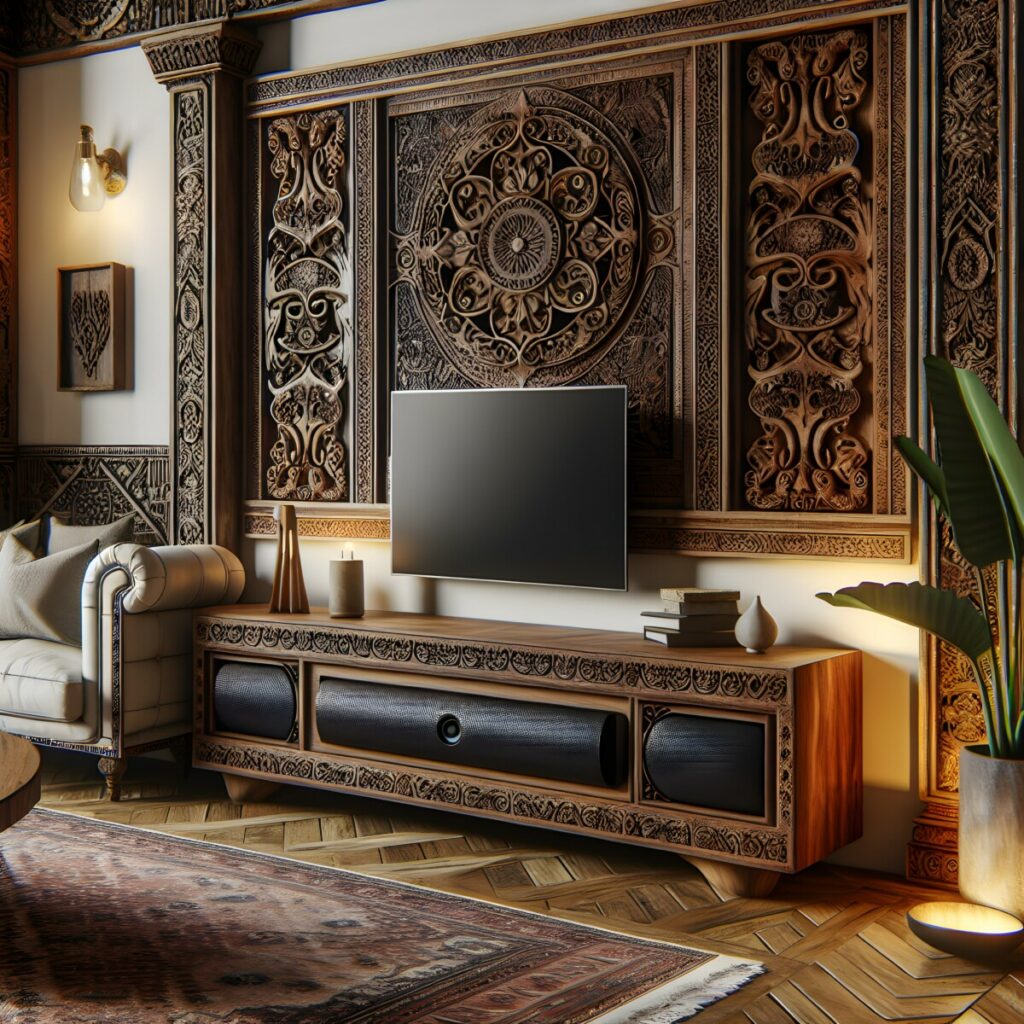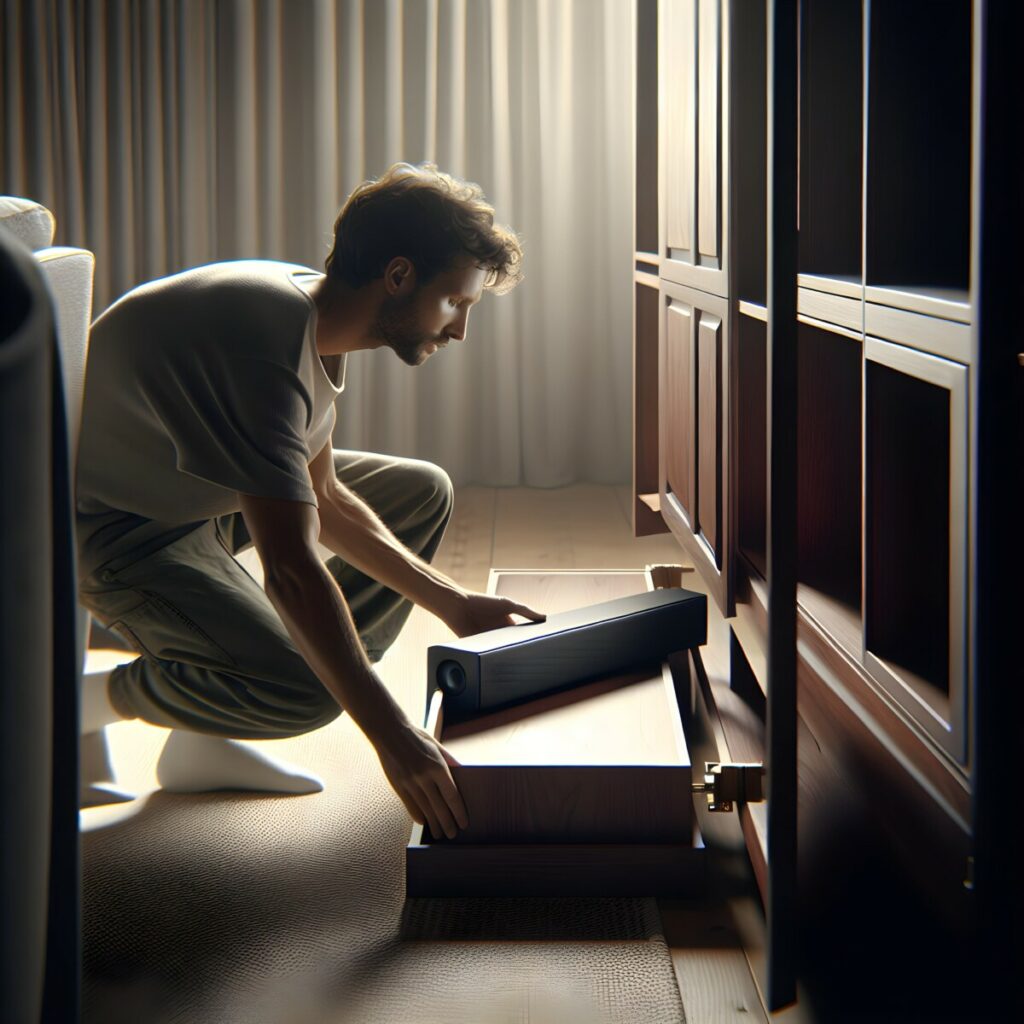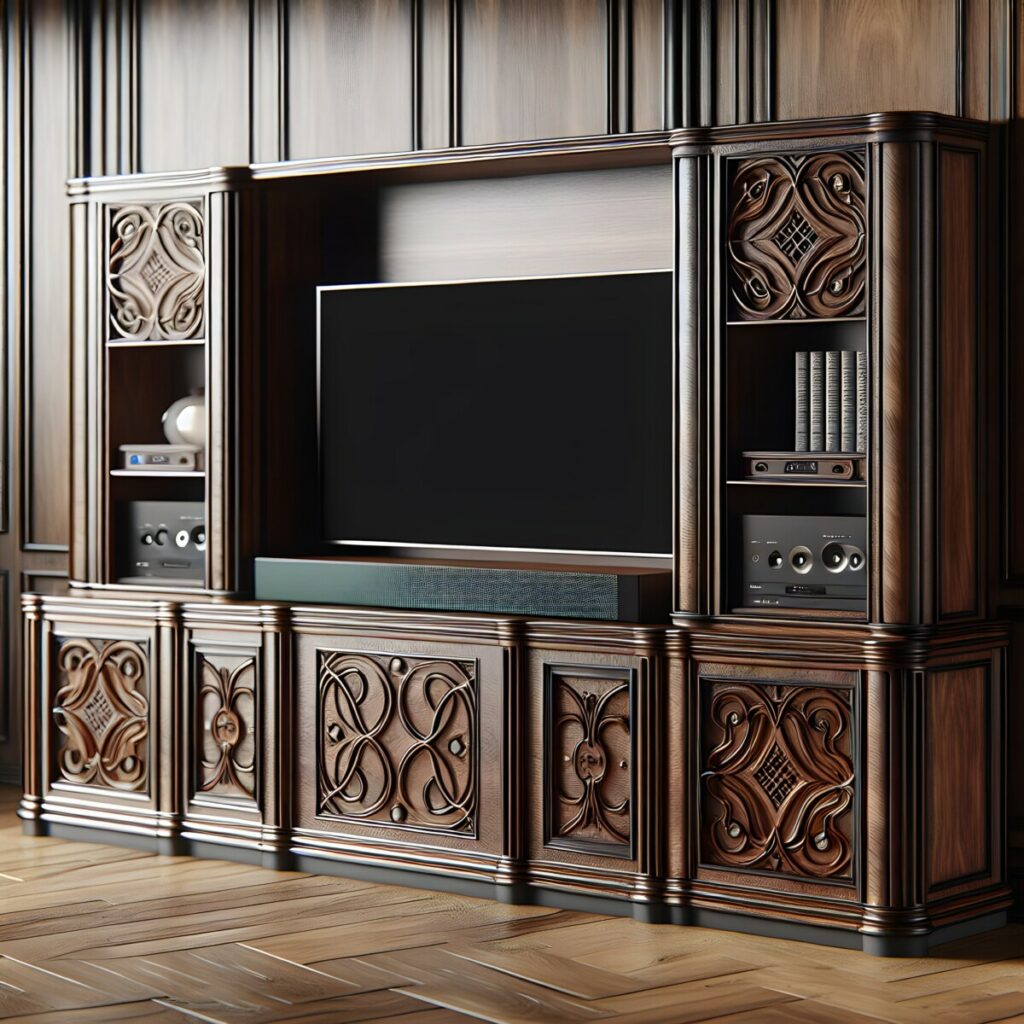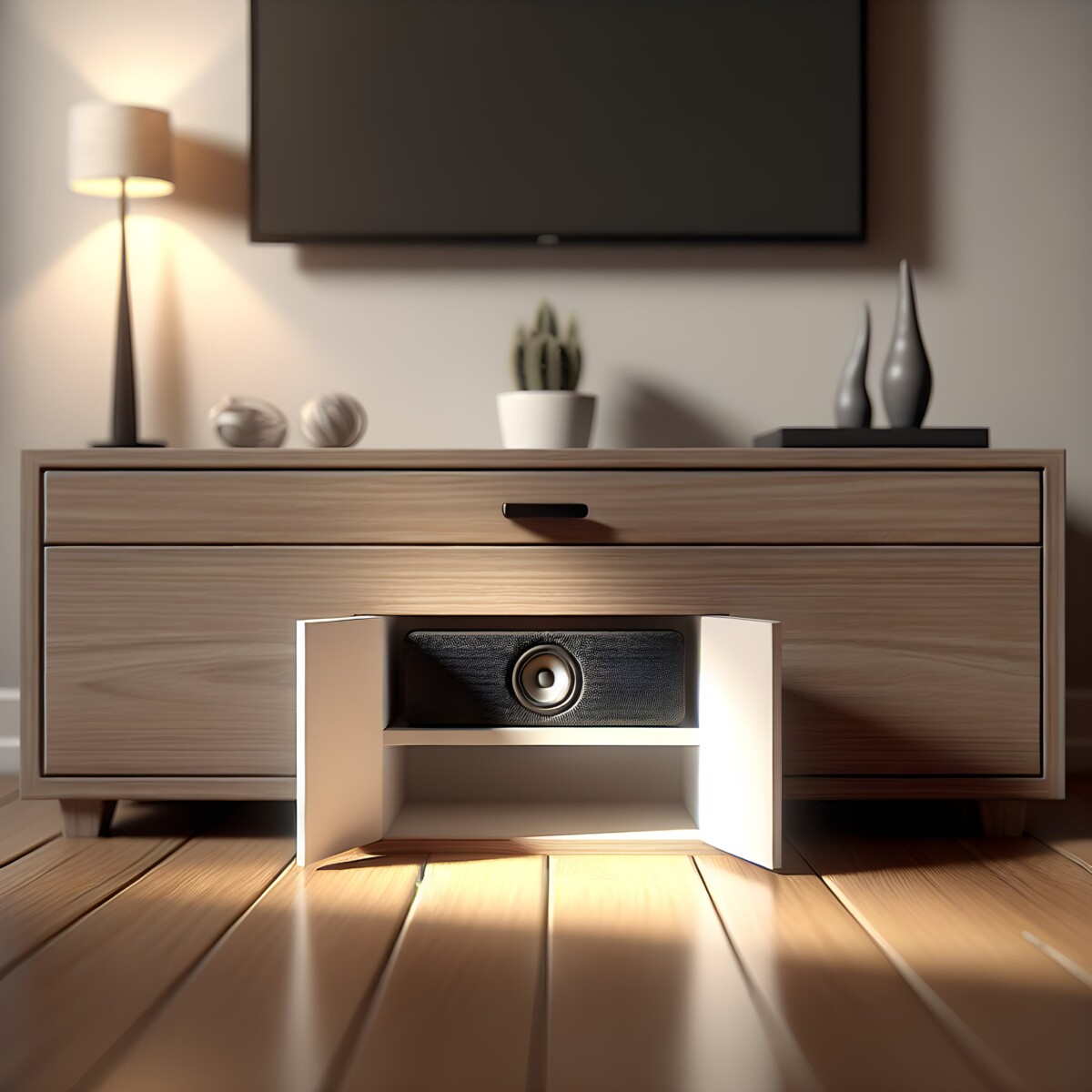As an Amazon Associate I earn from qualifying purchases
When considering where you will place your soundbar you might ponder the possibility of placing it in a cabinet.
Can you do this? Is it recommended?
Putting a soundbar in a cabinet is not a best practice but it can be done.
They offer a tidier look, but certain types run the risk of muffling the sound or causing issues with remote control signals.
For optimal audio quality, you’ll want to ensure that the cabinet doesn’t obstruct the sound pathway, and that your soundbar has enough space to “breathe” to avoid overheating.
There are technical considerations, as well, such as the cabinet’s material and the soundbar’s ventilation needs.
Key Takeaways
- Soundbar placement is crucial for audio quality in a home entertainment setup.
- Cabinets can house soundbars, but design and material impact performance.
- Technical factors including space and ventilation are essential for optimal sound.
Benefits and Challenges of Cabinet Placement

When considering placing your soundbar in a cabinet, it’s essential to weigh the aesthetic benefits and space-saving solutions against potential technical challenges like overheating and sound obstruction.
Aesthetic and Space-Saving Advantages
Aesthetics: A soundbar cabinet can significantly streamline the look of your entertainment area, creating a neat and tidy appearance that hides unsightly cables and equipment.
- Space-saving: By integrating a soundbar into a cabinet, you maximize the utilization of your living space, especially in smaller rooms where every inch counts.
Risks of Overheating and Sound Obstruction
Ventilation: Ensuring proper ventilation is critical when confining a soundbar to a cabinet, as inadequate airflow can lead to overheating, which may damage your equipment.
- Sound Quality: An enclosed cabinet might lead to sound obstruction, muddling audio clarity and bass response. It’s imperative to consider the material and design of the cabinet to minimize this impact.
Technical Considerations for Cabinet Installation

When installing a soundbar in a cabinet, there are several technical considerations to ensure the best performance.
These include proper ventilation to prevent overheating, managing cables for both safety and functionality, and facilitating unhindered signal reception for seamless remote control use.
Ensuring Adequate Ventilation
Your soundbar needs ample airflow to prevent overheating, which can damage the unit and affect sound quality.
Ensure there’s at least a few inches of space around the soundbar, particularly around the heat vents, which are often located on the sides or back of the unit.
If the cabinet has a closed back, consider drilling ventilation holes or using a fan to facilitate airflow. The importance of preventing overheating cannot be overstated for the longevity of your soundbar.
Cable and Wire Management
Proper cable management is critical not only for the visual appeal but also for the soundbar’s functionality:
- Power cables should be separated from audio cables to reduce electronic interference.
- Use cable ties or clips to organize cables and avoid a tangled mess.
- Consider the length of your cables; they should be long enough to reach the soundbar without being too taut or coiled.
- Install grommets in cabinet holes to protect cables from fraying.
Remote Control and Signal Reception
For your remote control to work properly, the soundbar’s IR sensor must have a clear line of sight. Consider these tips:
- If your cabinet has a solid door, you might need an IR repeater to transmit the remote control’s signal inside the cabinet.
- Mount the soundbar at the front edge of the shelf or use an open-faced cabinet to ensure the signal is not obstructed.
- Bluetooth/Wi-Fi enabled soundbars could offer alternative control methods that do not rely on IR and may be more suitable for cabinet installations.
Adhering to these technical aspects will help in maintaining the sound quality and functionality of your soundbar while housed in a cabinet.
Optimizing Sound Quality in Cabinet Placement
When positioning a soundbar in a cabinet, it’s crucial to understand how cabinet materials and the placement of the soundbar affect the audio quality.
To achieve the best sound performance, you’ll need to consider the acoustic properties and strategic positioning of your soundbar.
Acoustic Impact of Cabinet Materials
The materials your cabinet is made of can greatly influence the soundwaves from your soundbar.
Denser materials may result in a reduced bass response and can cause undesirable reflection and resonance.
For a more immersive audio experience, select a cabinet made from acoustically friendly materials that enable a clearer sound performance.
Woods with less density and fabrics can absorb the vibration, preventing excessive bounce of soundwaves that muddies the audio.
Positioning for Best Audio Performance
Proper positioning within a cabinet can enhance surround sound capabilities and Dolby Atmos effects, especially if the soundbar has up-firing drivers designed for reflecting sound off ceilings.
Here’s how you can position your soundbar for the best sound quality:
- Front Placement: Ensure the soundbar is at the front edge of the cabinet for optimal direct sound transmission.
- Avoid Enclosed Spaces: Place the soundbar in an open compartment or ensure enough clearance if behind cabinet doors to prevent stifling the sound and to allow for proper ventilation.
- Angle it Right: If the soundbar has up-firing drivers, angle it slightly for the soundwaves to effectively hit the ceiling and create that 3D immersive audio experience.
By paying attention to the interaction between your soundbar, the cabinet materials, and their placement, you will significantly improve your system’s overall audio performance.
Cabinet Design and Soundbar Compatibility

When selecting a cabinet to house your soundbar, key considerations are ensuring the dimensions match and that there are suitable options for secure mounting.
Selecting the Right Cabinet for Soundbar Dimensions
Your soundbar needs a cabinet that can accommodate its length, height, and depth without restricting the sound propagation or access to any ports and controls.
Measuring your soundbar and comparing those dimensions with the interior space of potential cabinets is essential.
Opt for cabinets with an open shelf or a floating entertainment stand design to avoid sound interference and to provide enough ventilation for the electronics, as enclosed spaces can trap heat and lead to overheating.
Ensure there’s sufficient space to allow for easy installation and access to other media components that might accompany the soundbar.
Mounting Options within Cabinets
Mounting your soundbar within the cabinet can be a neat solution if done correctly. You have two main options:
- Brackets: Some cabinets come with pre-installed brackets or offer the option to fit them. Use brackets designed for soundbars to ensure a secure fit and optimal positioning. This method keeps the soundbar snug against the cabinet’s structure, which is ideal if you’re short on space.
- Shelf Placement: If you prefer not to mount your soundbar, placing it on a shelf within the cabinet is a viable option. Ensure the shelf is stable and level. Keep in mind the soundbar’s connection to other components such as satellite speakers; it should not be positioned too far from these if they need to connect via cables.
Remember, a secure and compatible fit between your soundbar and cabinet will provide the best audio experience and ease of use.
Frequently Asked Questions
When considering soundbar placement, understanding the acoustics and limitations of certain positions can greatly affect your sound experience.
Can you put a soundbar on a table?
Yes, you can place your soundbar on a table, provided it is stable and close to ear level for optimal sound projection. Ensure there is no obstruction between the soundbar and your seating area to maintain sound clarity.
Can you put a soundbar in a recess?
Positioning a soundbar in a recess is technically possible, but be aware that it may lead to reduced audio quality. Sound reflection and absorption by the surrounding surfaces could muffle the sound, so it’s preferable to have an open or ventilated recess to minimize these effects.


